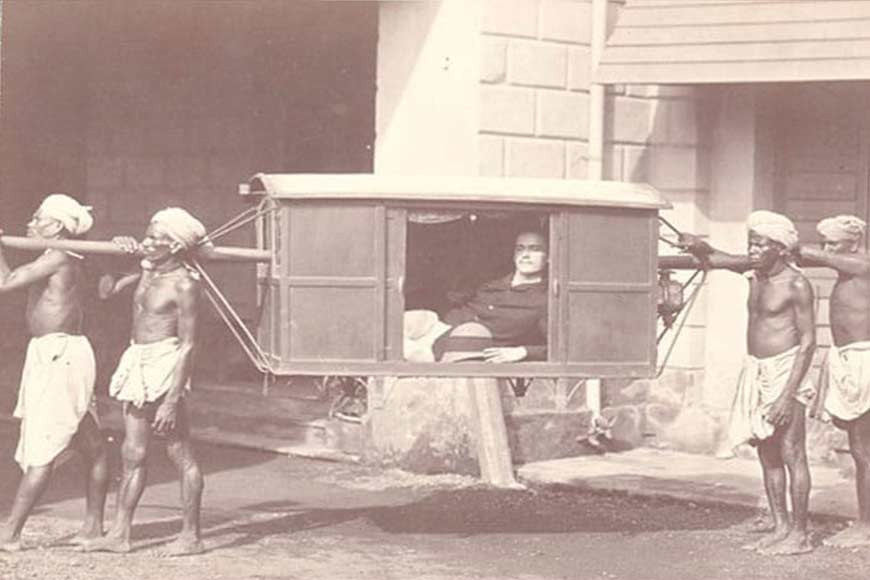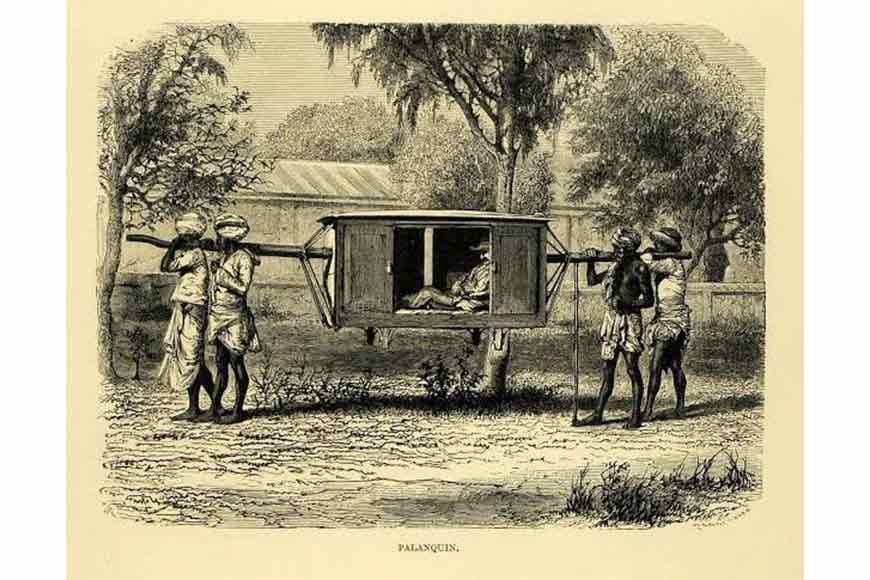How the British were mesmerised by Bengal’s ‘Palanquins’ - GetBengal story

Palanquins (Palki) being used as a medium of travel was a new concept to the British when they landed in Bengal. The palanquin was a covered mode for the transportation of one passenger inside it. There was a bed or a seat, it had curtains so that the interiors remained covered. It had poles in the front and back, which were used to carry the palanquin by the men on their shoulders. The British were both fascinated and a bit intimidated by this mode of transport. They saw palanquins being carried by men, who often screamed loudly to clear the road ahead. The men who carried palanquins were called “Kahar”. When someone travelled inside the palanquins, one could hear the kahars make humming sounds, which often perplexed the British even further. They assumed that the kahars were very tired and that is why they are making such sounds. To relieve the kahars, the British asked them to stop and would check if anyone was feeling sick. But they would be utterly shocked when they saw the smiling faces of the kahars, not even a touch of fatigue was visible. The British again went inside the palanquin. It started to move in the same manner, that same humming noise, the similar swaying of the vehicle continued. The British travellersinside could not bear much longer. They would stop the Kahars, pay them and leave.

Such an incident once happened to Augustus Cleveland, who had visited India for business purposes. The above-mentioned incident was his first experience of travelling in a palanquin. The palanquin was made of wood and a few palwans (strong men) were carrying it on their shoulders. Though Cleveland fled from the palanquin the first time, he still appreciated it a lot. In those days, it was one of the most famous modes of travel. If one had to travel, the palanquin was the best option. From home to office, again going home during lunch and so one required available travel modes, which was sufficiently facilitated by palanquins.
The foreigners became aware of the fact that the Asians have a weakness towards pilgrimage, known as “Tirtha Bhromon”, or “Tirtha Yatra”, which is a trip to the holy places to calm one’s mind. Samuel Johnson, an English writer had described the “Daaker palki” in his writings. In every post office, provisions of Daak-Palki were made, when someone was going on a pilgrimage or some other work, a simple call to the daak-palki would take care of the need. When asked for a daak-palki, immediately a palanquin would be ready at their doorstep. In the 18thcentury, cost of hiring a daak-palki from Kolkata to Kashi was Rs 500. If someone decided to go somewhere between these destinations, they had to pay one rupee and two anaas per mile or two rupees and four anaas per crosh (12 miles) – any one calculation was used.
Also read : Chugging along Kolkata’s oldest railway track!
There was a type of palanquin called “Mohona” or “Miyana,” that was more comfortable than normal palanquins as it was almost like a small bed. Beds and pillows were all stocked inside. Naturally, the passenger could also lie down while travelling. Evidently, this palanquin was the peak of luxury. Miyana was exclusively made by the Bengali artisans, who were experts in this field. The British coach-makers learned this skill from Bengal’s artisans. The native raja-maharajas loved the Miyanas, which is why their demand was high. The British companies did considerable amount of profit by selling these Miyanas.
They earned a lot of profit from the palanquins, simultaneously they did not shy away from spending on the palanquins. Many used to keep a private palanquin. One such person was George W. Johnson, a lawyer of the Supreme Court, who came to India towards the beginning of the 19thcentury. He stayed in India for just 3 years. The buzz around palanquins did not escape Johnson’s observation. According to him, without the daily necessities, it is better to stay away from palanquins. Keeping a private palanquin and maintaining it is very laborious. There was no shortage of theeke palkis, or palanquins that appeared at one’s doorstep, within five minutes, whenever they were called.”
On one hand, palanquins were loved. On the other, the sahibs (British) were not yet comfortable with the posture for sitting in the palanquin. They created a lot of drama around the very simple matter- “sitting inside the palanquin.” Later, the palanquins became afavourite medium of transportation for the Portuguese, but initially they thought that palanquins were “feminine” vehicles. The sahibs noticed that the way the natives sat inside the palanquin is very different from their usual posture. Even though the sahibs were not able to exactly copy the natives, they leaned on the palanquin and took the half-sitting posture to be their official way to sit inside the palanquin. No matter how uncomfortable the palanquins were for the sahibs, the fact that no one could move an inch without them remained intact. “So, it seemed best to simply accept the palanquins just the way they were,”an advice given by Thomas Bacon to most travellers.
The various kinds of palanquins or palkis fascinated the British, and so did the kahars or the palki bearers. Four hundred years ago, when Jahangir used to rule Delhi, an Italian guest, Pietro Della Velle had visited India. He was a famous musician and writer. Pietro loved palanquins, he appreciated the kahars by saying, “The men who bear are so satisfied with a very small reward”.
At the end of the 18thcentury, an Italian artist, Balsazar, had come to Calcutta. He had written a lot about palanquins. He wrote that “the structure of the palkis were very good. They were carried by four beharas or bearers. Harkaras and peyadas walked ahead of the palanquins. It is impossible for the passenger inside the palanquin to understand when the shoulders are being changed. They converse among themselves and even sing while walking with the palanquin on their shoulders. They walk miles without any fatigue, as if walking is their happiness.”










